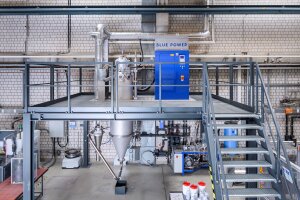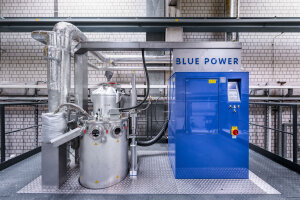The following equipment is used in the field of processing:
The vacuum induction melting and inert gas atomization (VIGA) system from Blue Bower/Indutherm enables the production of spherical metal powders for a wide range of applications such as additive manufacturing. With a crucible volume of 3.5 dm³, about 20 kg of steel can be melted in the vacuum induction furnace per atomization cycle. After initial evacuation, the furnace chamber can be variably flooded with argon or nitrogen during melting, so that oxygen contents below 1 ppm can be realized. The precise temperature of the molten metal is measured continuously by a thermocouple placed centrally in the crucible and integrated in the ceramic closure rod. The applied particle size distribution of the metal powders can be adjusted in advance via the temperature of the melt as well as specifically via the process parameters atomization gas pressure and temperature. Nitrogen is used as atomization gas, which is advantageous in the context of sustainability compared to argon and also enables process-integrated alloying with nitrogen.
Technical data
Application
Funded by the Deutsche Forschungsgemeinschaft (DFG) - 470572383 and the federal state of North-Rhine-Westphalia


The PBF-LB/M process is an additive, layer-by-layer manufacturing method in which a component is built by melting and fusing together layers of metallic powder using a high-energy, focused laser beam. This additive manufacturing approach enables the production of highly complex components directly from a 3D CAD model, without the need for product-specific tooling.
Technical Specifications:
Applications:
Funded by the Deutsche Forschungsgemeinschaft (DFG) - 555100690 and the Federal State of North-Rhine-Westphalia and the Federal Ministry for Economic Affairs and Energy / 7. Energieforschungsprogramm
The particle analyzer QICPIC is used to measure metal powder particle size distributions and shape parameters. By using dynamic image analysis, it is possible to view the contour of each individual powder grain and to determine data such as sphericity or the circumference. The material to be measured is fed by the VIBRI dosing unit with a constant mass flow. With the RODOS dry dispersing system, the powder is accelerated through the measuring cell by means of dry compressed air, allowing agglomerates to be broken up and reproducible measurements to be taken.
Key data
Application
Funded by the Deutsche Forschungsgemeinschaft (DFG) - 470572383 and the federal state of North-Rhine-Westphalia
The MC20 V is a vacuum induction casting furnace in a small format. By means of induction coils arranged around a ceramic crucible, sample material can be melted within minutes. By layering ceramics and graphite crucibles together, it is even possible to melt metal powder in order to carry out chemical analyses.
Technical data
Application
Funded by the Deutsche Forschungsgemeinschaft (DFG) - 470572383 and the federal state of North-Rhine-Westphalia
In powder manufacturing processes, the size of the powder grains produced varies around a mean value d50. d50 as well as the width of the particle size distribution can be adjusted by process engineering parameters. However, powder is always produced whose particle size lies outside the usable range. In technical powder metallurgical production routes, different powder particle diameters are required for different manufacturing processes. While processing with PBF-LB/M primarily uses grain sizes between 20 and 63 µm, the LMD process requires powder with grain sizes between 50 and 150 µm. However, powder particles with a diameter smaller than 20 µm are usually of no technical relevance and are separated because they significantly impair the flowability. Air classifying has established itself as a process for separating these particles. Using inert protective gas, fine powder is separated from coarse powder by means of specially adjusted turbine speeds. The ability to separate the fine fraction is much more pronounced than with sieving, as agglomerations of fine particles are also broken up and sorted out by the air movement.
Technical data:
Application:
The AS 450 control sieving tower is used to fractionate metal powders. After the fine fraction of the powder has been removed by air classifying, the remaining metal powder can be further fractionated by means of sieves with different mesh sizes. As the sieves are stackable, different sieves can be placed on top of each other and thus a particle size distribution can be determined by sieve analysis.
Key data:
Application:
Funded by the Deutsche Forschungsgemeinschaft (DFG) - 470572383 and the federal state of North-Rhine-Westphalia
The FEMTO low-pressure plasma system from the manufacturer Diener electronic enables the cleaning, activation, etching and coating of material surfaces. After initial evacuation, the vacuum chamber with a volume of 2 litres can be variably flooded with argon, oxygen, forming gas (95% N2 + 5% H2) or other non-flammable process gases during surface treatment, according to the application. The infinitely variable high-frequency generator (40 kHz, 0-100 W) can be used to generate a continuous plasma at a working pressure between 0.1 and 10 mbar over a period of 1 s to 99 min. Loading can be carried out with the aid of product carriers in the form of aluminium or stainless steel sheets, as well as borosilicate or quartz glass carrier structures. This allows simultaneous surface treatment along the chamber depth (280 mm) to be realised per treatment cycle, depending on the sample size. Possible areas of application include research and development work in semiconductor, microsystem or medical technology, the fine cleaning of complex-shaped components and the adjustment of defined surface conditions within optics and automotive technology.
Technical data:
• Internal chamber dimensions: Depth: 280mm
Diameter: 90mm
• chamber volume: approx. 2 litres
• atmosphere: Argon, oxygen, forming gas (95% N2 + 5% H2), other non-explosive and non-flammable gases possible
• HF generator: 40kHz, 0-100W
• working pressure: 0.1-10mbar
Application on material surfaces
• cleaning: Degradation of molecular contamination residues
• activation: Increasing the surface energy as a prerequisite for coating processes
• coating: with gaseous starting substances
• etching: anisotropic (physical) or isotropic (chemical)
Electro Discharge Sintering (EDS) is used as a rapid compaction process for electric conductive metal powders. A loose powder filling is compacted in the compaction tool by the hydraulic press unit. Subsequently, the discharge of a current pulse (capacitor) from the upper punch through the powder filling into the lower punch and the associated heating according to Joule within milliseconds results in a primary compaction. Due to the short process time of the method, only minor microstructural changes occur. For this reason, the EDS process is particularly suitable for compacting foreign powder particles that tend to diffuse or nanostructured powder particles.
Technical specification
Application
In SLA printing technology, a light-sensitive synthetic resin is initially present in a liquid state and is selectively cured layer by layer by a laser during the printing process. The advantages over FDM printers are the much better surface quality and the mechanical properties of the SLA-printed components. To produce a print, a CAD file in .stl or .obj format is required. This is sliced in the freely available software PreForm and converted into a .form file, which can then be transferred to the printer. Support structures for the print objects can also be created in PreForm, as well as scaling and copies.
Technical specification
Application
The vacuum drop furnace offers the possibility to perform under vacuum heat treatments with a fast quenching in water. The furnace can heat up under vacuum and run temperature ramps and, after quickly flooding the furnace with inert gas and opening a bottom door, drop a sample basket from the heating chamber into a bucket of water. This allows samples to be quenched very quickly while exposing them as little as possible to an oxidizing atmosphere.
Technical specification
Application
The vacuum drop furnace offers the possibility to perform under vacuum heat treatments with a fast quenching in water. The furnace can heat up under vacuum and run temperature ramps and, after quickly flooding the furnace with inert gas and opening a bottom door, drop a sample basket from the heating chamber into a bucket of water. This allows samples to be quenched very quickly while exposing them as little as possible to an oxidizing atmosphere.
Technical specification
Application
The HIP process is used to densify powdered (encapsulated), melt-metallurgical or additively manufactured components up to theoretical density. Porosity is closed by thermal treatment below the melting temperature and simultaneous superimposition of an isostatic gas pressure. A new generation of HIP systems such as the QIH 9 can also realize and control high cooling rates. Integrating heat treatment steps requiring fast cooling into the HIP process in a sustainable manner is possible. Thus, desired microstructures and material properties can be specifically adjusted. Such an integrated heat treatment into the HIP can result in exceptionally increased strength effects on dynamically stressed components and is, therefore, a key technology for long service lifes.
Technical specification
Application
With the KLS 05/13 laboratory chamber furnace, heat treatments with up to 1300°C can be carried out. A built-in switching and control system allows the desired temperature sequences or holding times to be precisely set. An external protective gas connection ensures that the heated sample material does not oxidize during the heat treatment.
Technical specifications
Applications
The muffle furnace is being used to heat treat metals. The sluicing of gas works against the scaling of the sample at high temperatures.
Technical specification
Application
The oven has a programmable control system, that endores a evenly emperature distribution up to 650°C.
Technical specification
Application
Tube furnaces with ceramic and steel furnace tubes for carrying out heat treatments and sintering. The heat treatments can be carried out under vacuum, protective (Ar) or reactive gases (e.g., nitriding in atmosphere). In addition, wettabilities of surfaces by melts can be investigated through an Inspection glass (contact angle measurement via a camera).
Technical specification
Application